Great Gorillas
Story photo credits: Marcus by Jamie Ohrt; Jack with ice globe at Halloween by Jamie Ohrt; Huerfanita by ABQ BioPark; Tusa the gorilla by ABQ BioPark; Matadi during holiday enrichment by ABQ BioPark.
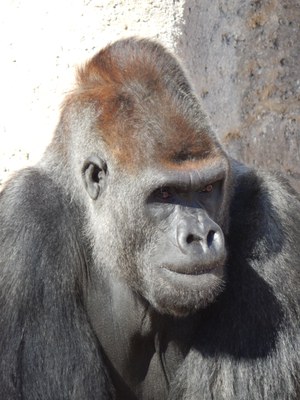 Gorillas will be gorillas
Gorillas will be gorillas
With his massive size, the ABQ BioPark Zoo’s resident silverback gorilla Marcus can be quite intimidating, but there is a lot more to gorillas than brute strength.
“They’re the strong, silent type,” said Jamie Ohrt, zookeeper.
She said that although these great apes are powerful, they are relatively calm in comparison to some of the other great apes such as chimpanzees.
“When they are happy we can sit there and hear grumbles for a long period. Some of them will even roll around, and play,” Ohrt said. “It can take them a while to get worked up and once they are, they walk around stiff, acting grumpy or banging the mesh just to let us know—in case we missed it—that they are upset.”
It’s difficult not to notice the gorilla’s physical and intellectual similarities to humans, but the BioPark’s gorillas live in a world that’s all their own. Zookeepers do a visual check each morning, train with the gorillas, and prepare their medicine, food supplements and enrichment, but after that it’s gorilla time.
“They’re gorillas and they need to know they’re gorillas,” Ohrt said. “For me, it’s really great when they get to go out in the yard and be gorillas.”
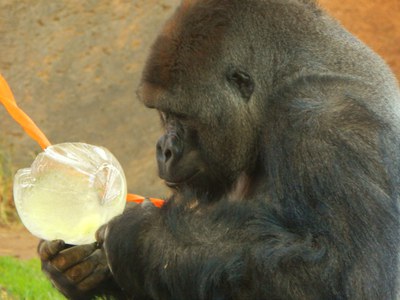 Bashful breeding and burgeoning bachelors
Bashful breeding and burgeoning bachelors
The ABQ BioPark has two separate gorilla groups, which live in separate yards—the silverback group and a second mixed social group.
Marcus leads the silverback group, which includes females Matadi and Tusa. A male such as Marcus transitions into a silverback when he has reached sexual maturity. Physically, you can identify Marcus’s silverback status by his silver-colored coat and enlarged sagittal crest (a ridge of bone running lengthwise along the midline of the top of his skull).
Marcus is recommended to mate with Matadi and Tusa in accordance with the gorilla Species Survival Plan. Matadi and Tusa have been off birth control for two years, but Marcus is a bit bashful, so breeding has been a challenge.
“If a keeper walks in on him, he gets a little shy and pretends he wasn’t doing anything,” said Ohrt.
Ohrt said the silverback group is mellow and balanced, with Marcus taking to his role of alpha male.
“Marcus has the silverback constant vigilance to make sure the girls are okay,” Ohrt said.
A triad of unruly bachelors rules the second gorilla group. Young males Jack, Mashudu and Hasani live alongside females Tulivu and Huerfanita.
Ohrt compares the three males to “adolescent teenagers”—they are busy establishing who’s on top in this community. They also practice their stancing skills. These talents will aid them in the future when challenging each other (and trying to impress females).
Although Tulivu is a female, she often gets involved in the action.
“I don’t think she’s quite figured out she’s not one of the guys,” Ohrt said.
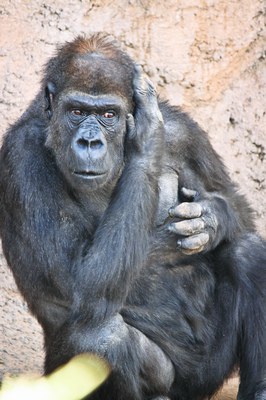 Little orphans
Little orphans
Sometimes animal mothers are not able to care for their babies, and surrogates take over. The Zoo has a number of surrogate parents and surrogate-raised animals.
Huerfanita (meaning “little orphan” in Spanish), was rejected by her mother upon her birth in 1973. Back then, humans often hand-raised apes when their mothers would not or could not care for them. After a stint as a newborn at Presbyterian Hospital, Huerfanita lived under the care of a local Albuquerque family before she returned to the zoo scene.
Times have changed, however, and zoos are placing greater emphasis on encouraging surrogate gorilla mothers. Former orphan baby Huerfanita is paying it forward in this respect—she has raised eight orphan gorillas, including Jack.
Jack and Huerfanita aren’t the only surrogate-raised gorillas, however—Tulivu was cared for by BioPark staff before returning to the gorilla habitat.
Making their lives better
Husbandry training (otherwise known as animal healthcare) is an important aspect of the zookeeper/gorilla relationship. Zookeepers like Ohrt ask the gorillas for a variety of species-appropriate behaviors that will help in their care.
“We’re trying to make it so that it’s not stressful for the gorillas and makes the tasks easier for them and us,” Ohrt said.
For example, Hasani is learning to open his mouth, show his teeth and take a toothbrush so zookeepers can keep his pearly whites clean.
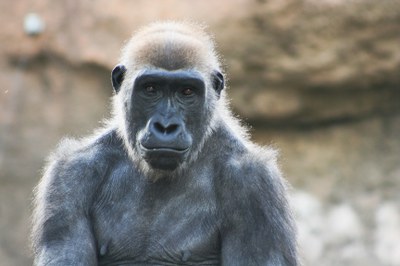 Zookeepers also ask gorillas to present their forearms as they train for voluntary blood draws. Gorillas also show their fingers for nail trims. In order to do this safely, gorillas present their arms through a special metal sleeve that’s attached to a mesh barrier. (Zookeepers always interact with gorillas through the safety of heavy-duty mesh to ensure human and animal safety. Certain areas of the mesh are modified to allow for special devices, such as the arm sleeve, or holes of different sizes. These modified mesh pieces are used for different types of procedures.)
Zookeepers also ask gorillas to present their forearms as they train for voluntary blood draws. Gorillas also show their fingers for nail trims. In order to do this safely, gorillas present their arms through a special metal sleeve that’s attached to a mesh barrier. (Zookeepers always interact with gorillas through the safety of heavy-duty mesh to ensure human and animal safety. Certain areas of the mesh are modified to allow for special devices, such as the arm sleeve, or holes of different sizes. These modified mesh pieces are used for different types of procedures.)
Ape house keepers also are training gorillas for cardiac ultra sound because captive gorillas are prone to cardiac disease. The information Zoo staff gathers from these ultra sounds will keep BioPark gorillas healthy and even benefit other gorillas throughout the United States.
Ohrt said gorillas are extremely intelligent and often quickly pick up on desired behaviors. She also said that overall, they love training.
“Some are in it for the treats and some really enjoy picking up new behaviors,” said Ohrt. “It’s just as enriching for them as it is for us.”
And the valedictorian of the gorilla class?
“Tusa’s one of the smartest gorillas we have, I think,” Ohrt said. “She picks up on training very fast and she is able to anticipate what we want before we even ask. She is also a creative painter.”
Great apes, happy apes
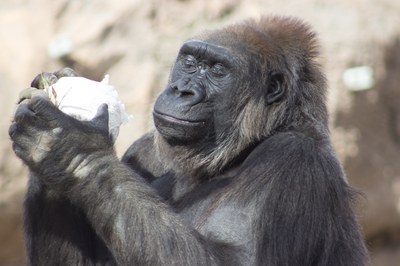 Environmental and behavioral enrichment provides choice, change and complexity to zoo animals’ days, and the BioPark’s mission is to incorporate an environmental enrichment program that will provide for the psychological well-being and overall enhanced animal welfare environment for all BioPark animals.
Environmental and behavioral enrichment provides choice, change and complexity to zoo animals’ days, and the BioPark’s mission is to incorporate an environmental enrichment program that will provide for the psychological well-being and overall enhanced animal welfare environment for all BioPark animals.
Boxes, toilet paper tubes and newspaper knots seem unlikely objects in a gorilla habitat, but they are important enrichment items and often contain food inside, which provides much-needed discovery opportunities for the gorillas.
Like many New Mexico residents, the gorillas like spicy food—one of their favorite special food items is oats sprinkled with cayenne pepper. Flavored ice treats are a tasty way to help them cool off during a hot Albuquerque summer day.
In the winter (when they spend more time indoors), the gorillas keep their minds active by interacting with more complex enrichment items and occasionally watching movies like “The Lion King.”
Whether providing special food, a movie or a new toy, zookeepers aim to create a variety of enrichment opportunities that will keep the gorillas entertained, happy and intellectually stimulated.
“We use taste, social structure, complex toys, auditory and tactile enrichment,” Ohrt said. “We really try to get it different every day. We’re constantly trying to give them new stuff.”

